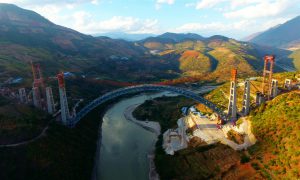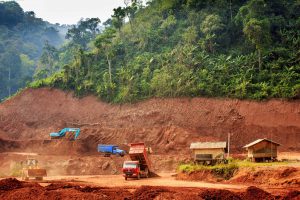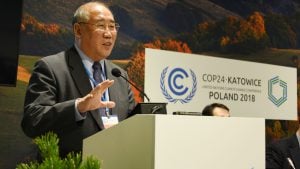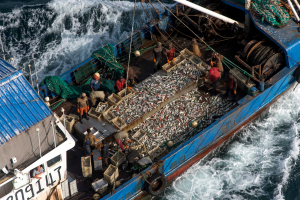It’s summer and Yangon is scorching hot. The hotel air-conditioning shuts down as it does several times a day due to electricity shortages. Shops and apartment buildings fire up growling diesel generators whose fumes mix poisonously with the exhaust of the second-hand Japanese cars streaming past.
I’m waiting for a ferry at Pansodan pier in the south of the city. Behind me is Yangon’s “Bund”, a row of colonial-era commercial and administrative buildings. In front is the Yangon river, whose waters flow gently, if a little murkily. On the other bank I can see the township of Dala. The view is flat and rural, a stark contrast to Yangon’s bustling cityscape.
Reaching Dala, I take a motorbike westwards, crossing the Twante canal via a steel bridge with an unpaved surface that makes the wheels skid. Farmers are transplanting rice in plots either side of the road. It’s countryside the whole way.
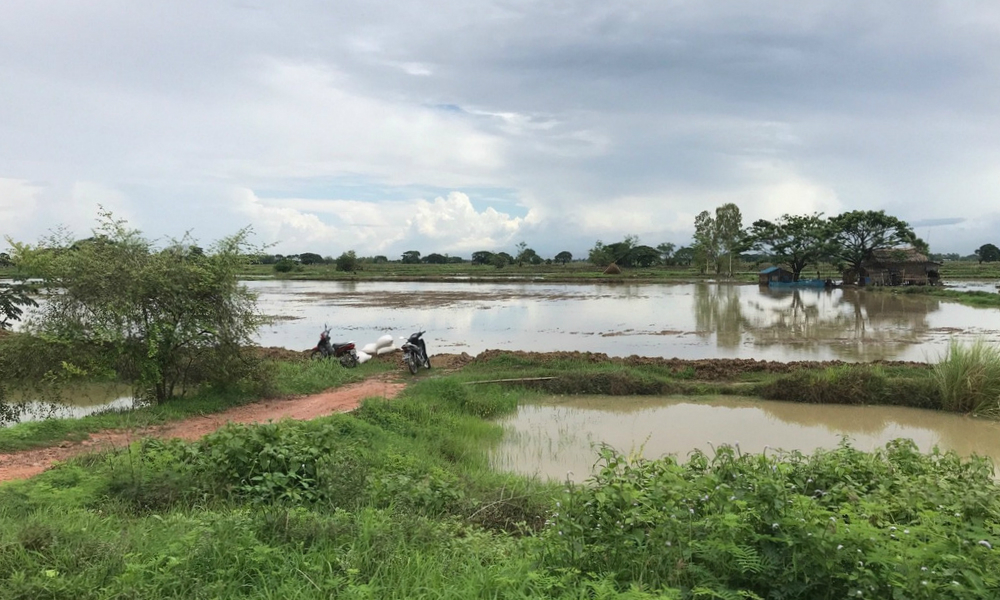
Paddy fields line the road north of the Twante canal. (Image: Jiang Yifan/China Dialogue)
I’ve come to see the area where a new city is being planned. Dubbed Myanmar’s Shenzhen, “New Yangon City” will cover 80km2 west of the Yangon river. Although only separated from the old city by the river, the area is relatively cut off. The only direct route is via the ferry to Dala.
This is merely Phase One of New Yangon. The longer-term plan, Phase Two, will cover a colossal 600km2 of river estuary land bounded on one side by the Yangon river and to the south, by the sea. Once finished, these two phases would make the new city twice the size of Singapore.
The plans envision a city that is both “productive” and “liveable”, with 24km2 developed by 2025 housing 180,000 to 750,000 people. By 2050, that is expected to have grown to 90km2, supporting a population of 1.2 million and providing 900,000 jobs.
Currently, just 50,000 people live on the land earmarked for Phase One, 80% of which is farmland.

Map of the planned area for New Yangon City
But why does Yangon need a new city?
According to the project’s “Socio-Economic Master Plan”, put together by management consulting firm McKinsey & Company and released in September 2018, Yangon is an economic powerhouse that contributes 26% of Myanmar’s GDP. Although currently home to only 12% of the population, this figure is growing quickly, putting the old city’s infrastructure under increasing pressure. Water, electricity, rubbish collection, public transport and parks are all stretched, impeding economic growth.
The plan argues that fixing these problems will be costly and time-consuming, and that building a new city therefore seems logical. “A distinct advantage of greenfield cities is that they offer a clean slate and a chance to ‘get it right’ the first time, avoiding costly remediation later,” it states.
The project is being executed by the New Yangon Development Company (NYDC), which is wholly owned by the Yangon regional government. At a meeting with journalists from China and Southeast Asia earlier this year, the company stated that job creation was the main reason for building the new city. External conditions are ripe: the China-US trade dispute has pushed Chinese manufacturers to shift operations to Southeast Asian countries. NYDC hopes to grasp the opportunity by attracting low-skilled labour-intensive sectors, such as textiles and furniture, to the new city.
In the same month as the Master Plan was released, “New Yangon City” was named in the memorandum of understanding establishing the new China-Myanmar Economic Corridor. Plans outlined in this agreement include building highways, railways, ports, power links and other infrastructure to connect Yunnan in southwest China with Myanmar’s Kyaukphyu Special Economic Zone (SEZ) and New Yangon. Part of China’s Belt and Road Initiative, the corridor is seen as one of the country’s attempts to reduce its reliance on the Malacca Straits, through which a large proportion of trade currently travels.
New concepts for development
A more developed master plan, drawn up by architectural firm AECOM Singapore, was released in May 2019. According to this plan, the western third of Phase One will be set aside for industry and the remainder for homes and commerce. It will be connected to surrounding areas by 12 bridges spanning the Yangon and Pun Hlaing rivers and the Twante canal.
NYDC’s head of city planning and development, Alicia Khine, explained the industrial zone would be convenient for transporting goods to Yangon port for export overseas. The zone will include areas for both light and heavy industries as well as an “innovation centre” to boost the development of high-tech industries. On the community level, planners have designed a ribbon-shaped park that they hope will become a “cultural spine”, packed with facilities to provide visitors with a taste of “Myanmar’s past, present and future”. The overall design follows those of pioneering city planner Le Corbusier, with abundant green spaces, buildings in grid format and functional zoning. But unlike some unrealistically ambitious new cities currently being built or planned in developing countries, the New Yangon outlined in the 2019 master plan appears to remain faithful to Myanmar’s socio-economic circumstances.
Notably, the plan retains almost all of the area’s 20-plus existent villages. Only farmland will be requisitioned. Alicia Khine explained compensation will be in the form of land rather than money or housing. Those with agricultural land usage rights will be able to keep 20% of the area they originally held. Once construction begins, they will be able to build on this land according to its planned usage, thereby giving them a stake in the new city.
Considering that one-time buyouts for expropriated farmland often result in loss of livelihoods, retaining land rights may be fairer, allowing farmers to share in the benefits if the development is successful.
A Yangon-based business consultant told me that, in her recollection, this was the first time Myanmar had given compensation in the form of land-usage rights. In the past, resettled farmers have usually been offered housing and cash, with little concern for their future livelihoods. This time, according to Alicia Khine, farmers waiting for returns on their land-usage rights will have job opportunities in construction and the service industry while the new city is built. In addition, once the industrial zone is finished, younger farmers will receive vocational training to help them find jobs in the manufacturing sector. From NYDC’s perspective, the people in these villages, who until now have lived without sewage systems and running water, will see their lives transformed.
A Yangon reporter told me the city already has more than 20 industrial zones and doesn’t need any more. But the business consultant said she believes these zones suffer from poor planning, management and maintenance. She added that industrial zones with better planning, like the one in the new city and the Thilawa SEZ to the southeast of old Yangon, will help attract foreign investment.
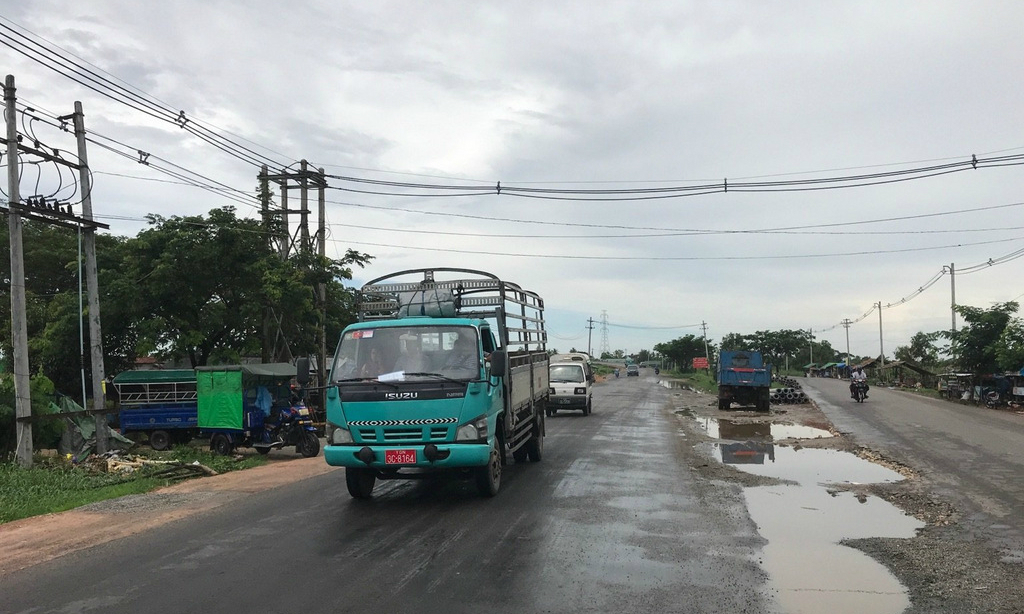
A public road in the area where Phase One of New Yangon is set to be built (Image: Jiang Yifan/China Dialogue)
The tendering process draws criticism
Despite these positives, the project has been mired in controversy from the start, particularly over the transparency of the tendering process.
In August 2014, Burmese media revealed that the then chief minister of Yangon, Myint Swe, had awarded the contract for the new city to a company without putting it to tender first. The awarded firm, Myanmar Say Ta Nar Myothit, was controlled by two Chinese businessmen who were very close to Myint Swe. Lawmakers criticised the decision as lacking transparency, forcing the Yangon government to withdraw the contract and announce a new tendering process. When they held the bid the following July, three companies were awarded the contract. Then the project was put on hold following the general election win of Aung San Suu Kyi’s National League for Democracy party in 2015. It wasn’t restarted until March 2018, when the new regional government established the NYDC.
In May 2018, the NYDC signed an agreement with the China Communications Construction Company (CCCC) to draw up a “pre-project document” on the construction of the new city. This document was set to include specifications for a collection of engineering projects constituting the first part of Phase One: two bridges; 26km of roads; five resettlement villages; a 10km2 industrial zone; water-treatment facilities and sewage systems; and power distribution and transmission infrastructure.
The signing of this agreement and the preparation of the pre-project document does not mean that CCCC will definitely be awarded the contract. It still needs to go through a special bidding process called the “NYDC Challenge”, based on the “Swiss Challenge” public procurement process. Under this system, a company comes up with an initial project proposal, defining the basic details, and then makes it public so other bidders can use it as the basis for their own proposals.
This model can help get the bidding process started when a government lacks the expertise to design a public procurement project. However, it is also thought to give the initial proposal designers too much of an advantage. In the NYDC Challenge, the winner will set up a joint-venture company with NYDC through which they will jointly carry out the construction of the new city’s infrastructure and share the profits.
NYDC’s decision to adopt this method of public procurement has once again given rise to media criticism that it lacks transparency and that the contract might be awarded secretly. Deepening the media’s suspicions is the fact that, between 2009 and 2017, CCCC was debarred by the World Bank.
Meanwhile, the media has also expressed concerns that since the words “New Yangon City” appeared in the memorandum of understanding on the China-Myanmar Economic Corridor, its investors and contractors would inevitably end up being Chinese companies. NYDC has countered that the bidding process is public. It claims it is not keeping the contract for any Chinese company, and firms from Korea, Japan, Thailand and India have all expressed an interest in bidding.
But progress on the tender has been long delayed. NYDC initially said the pre-project document would be finished and released by mid-February 2019, after which the bidding process could start. To date, the document has still not been published, even though land was being expropriated for the project as early as June.
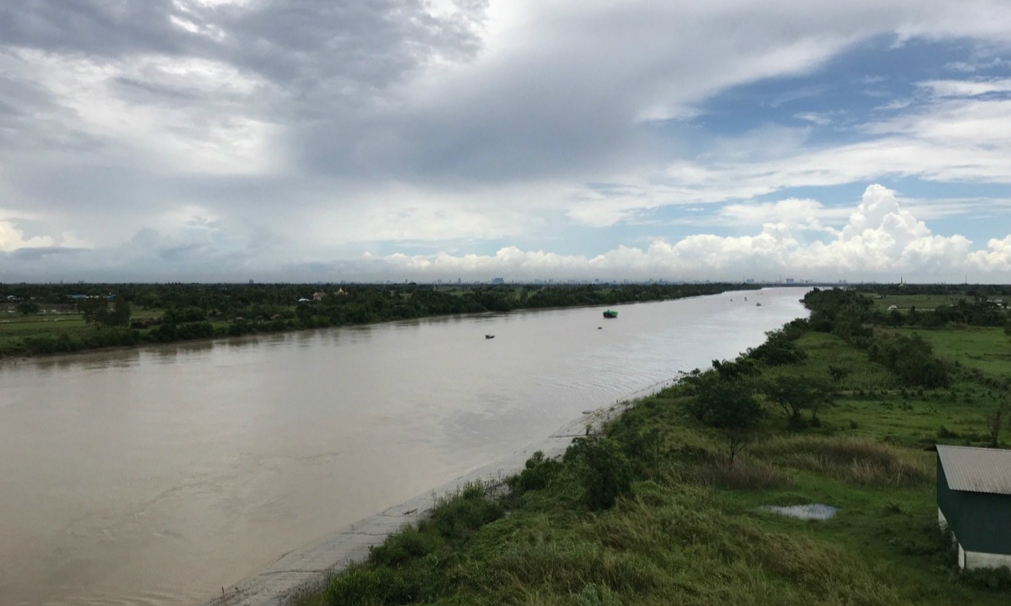
Looking east along the Twante canal, old Yangon’s skyline can be seen faintly in the distance (Image: Jiang Yifan/China Dialogue)
Will Myanmar reap any tangible benefits from the new city?
At an event in February this year, NYDC CEO Theim Wai revealed that Myanmar’s contribution to the project would be land valued at US$144 million. He said CCCC had proposed an investment of US$1.68 billion for the projects to be outlined in the pre-project document. This would give the two sides stakes of 8% and 92% respectively.
But future returns from these investments will not be based on these stakes. Instead, they will be based on a separate agreement whereby NYDC will initially receive only 5% of the profits, while the winning bidder will get 95%. Once the winning bidder has earned back their investment and an additional 13% “internal rate of return”, the share of profits will be changed to 25% for NYDC and 75% for the winning bidder. But that might not happen for another 30 years.
What has proved most contentious in this is the value of the land Myanmar will contribute. An op-ed published earlier this year points out that NYDC’s investment is based on a price of US$5 per square metre, which, it argues, is 10 times lower than the market value. This gives Myanmar far less of a stake in the project than it should have. The article also points out that Phase Two is on a much larger scale, and it is not yet clear if the same sharing arrangement will be used. If it is, the winning bidder will enjoy the lion’s share of the profits for a considerable length of time.
Another op-ed by the Eleven Media Group elevated the issue to one of “national sovereignty”. It says that as part of the China-Myanmar Economic Corridor, New Yangon is bound to be controlled by Chinese companies. It may also be filled with foreign workers. This is because a stipulation in Myanmar’s economic law that at least 75% of workers must be Burmese has recently been scrapped. Referring to controversies over two projects in Sri Lanka, the article speculates that Yangon’s new city may repeat the same blunder; that is, Chinese companies will be able to control large tracts of attractive land for extended periods of time, even forcing the host country to fall into a “debt trap”, thus harming Myanmar’s national sovereignty.
However, the construction of the new city will not involve borrowing money from China. In the introduction to NYDC’s Socio-Economic Master Plan, chief minister of the Yangon region, Phyo Min Thein, writes: “We are using the regional government’s land assets as the seed equity. This will ensure that we do not create unreasonable debts that our citizens and successive generations would find difficult to pay back.”
The controversies in Sri Lanka were in part to do with the projects’ 99-year leases to China and the fact that one of them was a strategically located port. In contrast, New Yangon is an urban and industrial project. The Eleven Media Group article does not explain under what circumstances the project would endanger sovereignty, and the author, Phyo Wai, has not responded to requests for comment.
These concerns must be seen in context, however. A series of China-driven strategic projects in Myanmar – such as the Myitsone Dam, the Kyaukpyu deep-sea port and China-Myanmar pipeline – involving issues such as the environment, heritage preservation, regional stability and fairness of returns on investment, have sparked huge controversy and strong public sentiment over the years.
Concerns about rising seas
Another point of controversy is New Yangon’s planned location. The Irrawaddy reported in 2018 that the site is prone to flooding. The article cites a retired city planner with more than 20 years of experience working for the Ministry of Construction. He says that when the previous military government looked at expanding Yangon in the early 1990s, it discounted the area because of its elevation, which ranges from a high of only 5m above sea level to a low of 2.1m. In 2016, an Asian Development Bank flood-management study warned that the west bank of the Yangon river could easily face cyclonic surges of 2-5m, comparable to the surge caused by Cyclone Nargis in 2008. The city planner states that developing this area would inevitably require the hugely expensive use of large amounts of earth to raise the level of the ground.
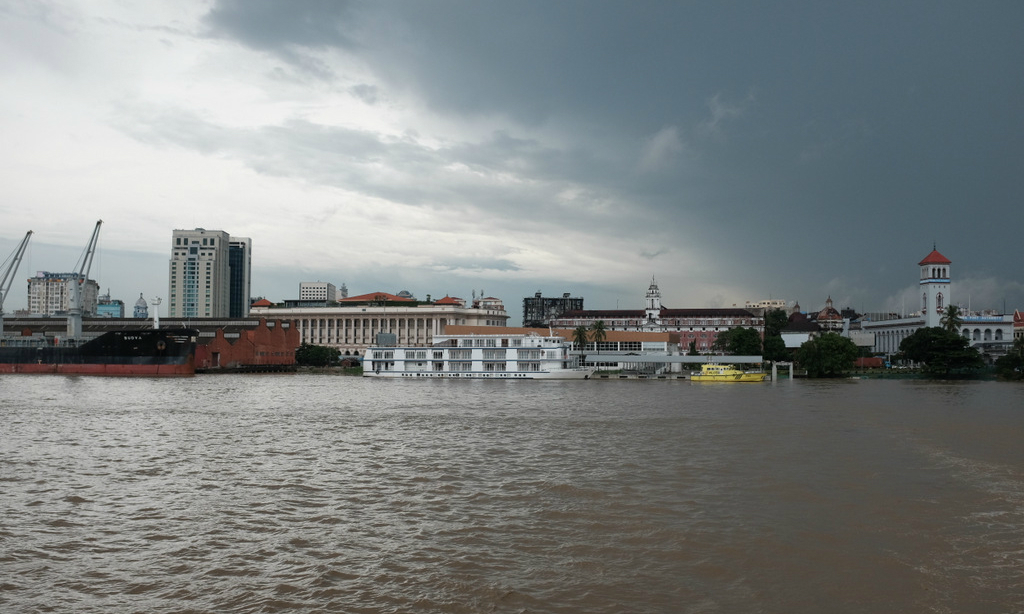
A view of old Yangon from the south bank of the Yangon river (Image: Jiang Yifan/China Dialogue)
In response to these worries, NYDC commissioned Dutch engineering consultancy Royal HaskoningDHV to carry out a flood-risk assessment. The executive summary of the report, which came out at the end of May this year, says the new city would be prone to three sources of flooding – tide and storm surges, river discharge and rainfall – but the risk could be mitigated.
Asked about the flood-prone site, NYDC’s Alicia Khine replied without any hesitation: “It’s very bad.” She said that during cyclone seasons, the lower levels of many homes in the area become flooded every day at high tide. The price of farmland in the area has also been seriously impacted since Nargis struck in 2008. Only certain varieties of rice can now be planted, and only in certain areas.
When asked why NYDC had not selected a site further from the river or the coast, she said the current location is only 15 minutes drive from old Yangon. A more distant site would increase the cost of transporting products from the industrial zone. “We believe that the flood risk can be managed with technological solutions,” she said.
Royal HaskoningDHV’s report recommends three coping strategies: constructing around 30km of dykes along the Yangon and Pun Hlaing rivers and the Twante canal; building elevated roads set back from the river banks but roughly parallel to them; and retaining a large number of green spaces and bodies of water within the new city to impede flooding – a kind of “sponge” design.
Myanmar is particularly vulnerable to sea-level rise. New research by thinktank Climate Central shows that if global temperatures rise by 2C, most areas in both phases of the new city will be prone to annual floods by 2050. If greenhouse gas emissions remain unchecked, by 2100 most of the same area could be below the tideline. A 2017 WWF report predicted that between 2080 and 2089, sea levels around Myanmar will be 37-83cm higher than at the start of the century, although they could rise by as much as 122cm. Royal HaskoningDHV based its report on the assumption that over the 100-year “design life” of the new city, sea levels will rise a maximum of 90cm.
 Land in the Yangon area at risk of an annual flood in 2050 based on a 2C rise in global temperature (Source: Climate Central)
Land in the Yangon area at risk of an annual flood in 2050 based on a 2C rise in global temperature (Source: Climate Central)
Some wonder whether there is a better location for New Yangon. Another Irrawaddy article written by an urban planner points out that dozens of square kilometres of land to the northeast of the city lie vacant. This land is not flood-prone and is also close to Yangon’s circular railway line and the planned Hanthawaddy airport. Moreover, construction in this area would not necessarily require the requisition of large amounts of farmland or the construction of numerous new bridges and roads.
The plan for New Yangon comes at a time when developing countries from Asia to Africa are embarking on a new city building boom. But when another nation’s money is used to bankroll construction, those in charge will inevitably face tensions between the needs of local people and the demands of international capital.


